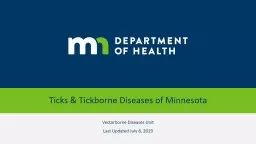

Ticks amp Tickborne Diseases of Minnesota Vectorborne Diseases Unit Last Updated July 8 2019 What is a tickborne disease and why should you care about it People can get a tickborne disease when they are bitten by a tick that is infected with a disease agent ID: 764988
Download Presentation The PPT/PDF document "Ticks & Tickborne" is the property of its rightful owner. Permission is granted to download and print the materials on this web site for personal, non-commercial use only, and to display it on your personal computer provided you do not modify the materials and that you retain all copyright notices contained in the materials. By downloading content from our website, you accept the terms of this agreement.
Ticks & Tickborne Diseases of Minnesota Vectorborne Diseases UnitLast Updated July 8, 2019
What is a tickborne disease and why should you care about it? People can get a tickborne disease when they are bitten by a tick that is infected with a disease agentThe number of people getting tickborne diseases is increasing throughout the United States, including Minnesota Personal protection methods can help keep you safe from tick bites and tickborne diseases while enjoying healthy outdoor activities
Goals of Presentation Be able to recognize ticks of public health concern in MNBe aware of tickborne diseasesRecognize basic signs and symptoms Seek early diagnosis and treatment Know when and where tickborne disease risk is highest Practice prevention methods Know who to contact for more information
Blacklegged (Deer) Tick Lyme diseaseA naplasmosis Babesiosis Ehrlichiosis Powassan virus diseaseBorrelia miyamotoi disease 3 Main Ticks of Public Health Concern in Minnesota American Dog (Wood) TickRocky Mountain Spotted FeverTularemia Lone Star TickEhrlichiosisTularemiaHeartland virus diseaseBourbon virus diseaseSouthern Tick-Associated Rash Illness (STARI)
Tick Life Stages
Blacklegged Tick Life Cycle
Larva Nymph Adult Blacklegged Tick Life Stages
Engorged Adult Female Blacklegged Tick
Questing What blacklegged ticks do:Search for a host from the tips of low-growing vegetation Sense body chemicals and other cues from potential hosts Climb onto a person or animal near ground level as they walk by What blacklegged ticks don’t do : JumpFlyFall from treetopsSee
Blacklegged Tick Habitat
Tickborne Disease Risk in Minnesota Photo courtesy of MN Department of Natural Resources (accessed 2/16/2018) http:// www.dnr.state.mn.us/biomes/index.html
Distribution of Blacklegged Tick Populations by County in Minnesota
What are the symptoms of a tickborne disease? Many tickborne diseases have similar symptomsInitial symptoms usually show up within 2-4 weeks of being bitten by an infected tickWatch for symptoms like: Rash Fever Headache Fatigue Muscle or joint aches
How are tickborne diseases diagnosed? If you think that you may have a tickborne disease, contact your health care provider as soon as possibleYour health care provider can determine if you have a tickborne disease based on your: History of being around wooded or brushy areas (where ticks may live) Physical examination Laboratory tests
Are tickborne diseases treatable? Most tickborne diseases are treatableFor most people, the prognosis is good and symptoms go away after treatmentTalk with your health care provider about managing symptoms that have not resolved after treatment
Lyme Disease Borrelia burgdorferi Symptoms Characteristic Rash (erythema migrans ) Fever Muscle or joint painFatigueDiagnosisHistory of exposure to ticks or wooded areasPhysical examinationLaboratory testingTreatmentAntibiotics
Anaplasmosis Anaplasma phagocytophilum Symptoms Fever Severe headache Muscle or joint pain Severe complications and death possible DiagnosisHistory of exposure to ticks or wooded areasPhysical examinationLaboratory testingTreatmentAntibiotics
Babesiosis Babesia microti Symptoms Fever Headache Fatigue Severe complications and death possible DiagnosisHistory of exposure to ticks or wooded areasPhysical examinationLaboratory testingTreatmentPatients without symptoms may not require treatment Combination of anti-protozoal and antibiotic
Rare/Emerging Tickborne Disease Agents in Minnesota Powassan virusEhrlichia muris eauclairensis Borrelia mayoniiBorrelia miyamotoiRickettsia rickettsii*Francisella tularensis**transmitted by the American dog (wood) tick, not the blacklegged tick
Protect Yourself from Tickborne Diseases 1) Know when and where you’re at riskPrimarily Mid-May through mid-July Wooded and brushy areas – Blacklegged tick Grassy or wooded areas – American dog tick 2) Wear EPA-registered tick repellent DEET 20-30% on skin or clothingPermethrin 0.5% on clothing3) Check yourself for ticks Undress and shower after being outdoorsCheck at least once a dayRemove ticks ASAP!
How to Remove a Tick
Other Tick Prevention Methods Tumble dry clothing on high for ≥ 6 (dry) - 60 (wet) minutesKeep lawn and trails mowed short Remove leaf litter and brush Create a barrier between your yard and woods Talk with your vet about tick preventatives for your pets Image courtesy of Kirby Stafford, Connecticut Agricultural Experiment Station, New Haven
Be Aware of Tickborne Disease S ymptoms Contact your doctor if you notice: Rash Fever Headache Fatigue Muscle or joint aches
Thank You! Questions? Minnesota Department of Health Vectorborne Diseases Unit 625 North Robert StreetPO Box 64975Saint Paul, MN 55164-0975651-201-5414http://www.health.state.mn.us/ticks